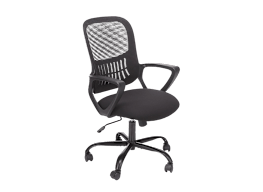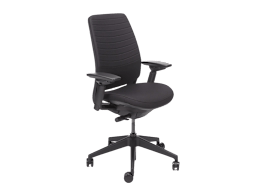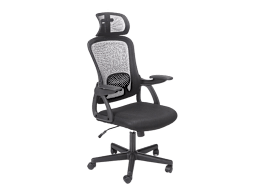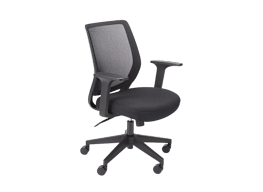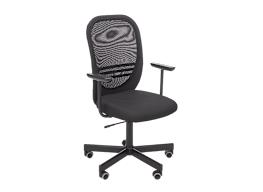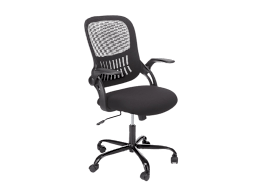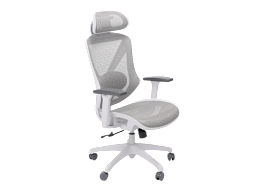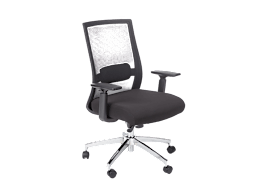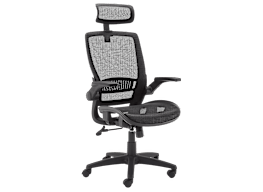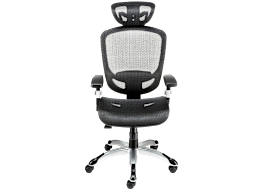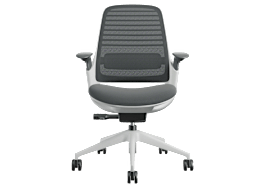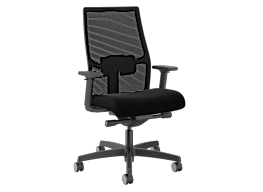Best Standing Desks of 2025
Adjustable desks vary in their controls, ease of assembly, and height range. And if you’re under 5 feet, 3 inches tall, options are limited.
When you shop through retailer links on our site, we may earn affiliate commissions. 100% of the fees we collect are used to support our nonprofit mission. Learn more.
A standing desk could be the best upgrade for your home office. Having used one almost daily for the past seven years, I can say without hesitation that my standing desk is vital to my productivity and well-being. It’s one of the best furniture purchases I’ve made.
In its tests of six standing desks, Consumer Reports found that the biggest differences are in how low a desk can go (important for us short-statured folks), ease of assembly, and controls.
Except for the Ikea Bekant standing desk, all the models we evaluated have a memory feature that can automatically adjust the desks to the heights you set. We also looked at two desks with interval timers that prompt users to switch positions. These can all be useful features, but some controllers were much simpler to use than others.
Standing Desk Test Results
We scored the desks on three criteria.
Ergonomic design: The desk’s ability to accommodate a wide range of people at appropriate sitting and standing heights.
Ease of use: How easy it is to adjust the desk to different heights using its controller. We tested only electric standing desks because the manual kind, which require using a crank to raise or lower the desk, add a significant hurdle to switching positions throughout the day.
Ease of assembly: Based on assembly time, tools required, and how easy the instructions are to follow.
In addition to those factors, you’ll want to consider pricing, which ranges from around $500 to more than $1,000 in the models we evaluated. You’ll also want to consider options for customizing. Plus, some models offer desktops in a wide range of sizes and materials, which can help make your desk more useful and attractive.
Price as tested: $599
User height range: 5’1” to 6’5”
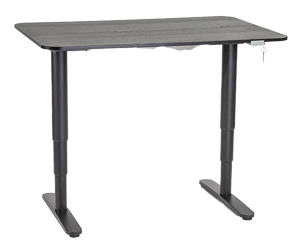

The Ikea Bekant is the best option if you want to see a standing desk in person and take it home the same day—assuming there’s an Ikea store near you. Ikea also offers a generous 180-day return period for opened products, which means you can test-drive it at home for months. (Thirty-day return policies are more common.)
The Bekant earns our top score for ergonomic design because it fits a wider range of shorter users than the competing standing desks we looked at. The desktop can be lowered to just under 23 inches, and raised as high as 48 inches, which should comfortably accommodate users with heights from 5 feet, 1 inch to 6 feet, 5 inches.
Our evaluation participants said the Bekant’s controller is extremely easy to use, with just two big buttons with arrows to raise or lower the desk. However, it lacks memory presets, so you’ll need to fiddle with the controller every time to get a Goldilocks fit. If memory presets are important to you—and our feedback from current owners of standing desks shows that it’s a feature worth having—you’re better off looking at one of the other standing desks in this guide.
The desk lacks an anti-collision feature, which stops the desk from lowering if, say, it encounters the armrest of your chair, your lap, or a pet or a child camped out below. But this desk does have a physical lock with a key that can be removed to keep someone from inadvertently raising or lowering the desk.
In true Ikea fashion, the clear graphical assembly instructions and provided tools make this desk one of the easiest to put together. It took our two test technicians 37 minutes to complete the assembly.
The Bekant desktop is made of particleboard and available in a few finishes: black, white, and stained oak veneer. The legs are available in black or white. We evaluated the model with a 47.25-inch wide by 31.5-inch deep desktop; there’s a 63-inch wide model as well.
One final note: The Bekant’s desktop is ½ inch thick, considerably thinner than the other desktops. Most are 1 inch thick or more. In addition, the claimed lifting capacity is just 154 pounds, while some competitors claim lifting capacities above 250 pounds. If you plan to stash heavy electronics items on the desk, such as multiple monitors, a printer, and a desktop PC tower, one of the other desks we evaluated could feel sturdier.
Buy at: Ikea
Price as tested: $695
User height range: 5’3” to 6’8”+
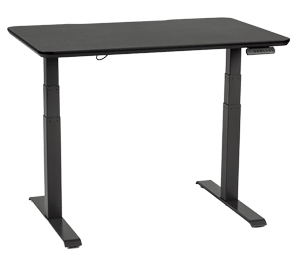

Vari’s standing desk costs more than most models on this list, but it’s the easiest to assemble. It also has the thickest desktop at 1.25 inches, vs. 1 inch or less for other desks. Two of our testing participants remarked on the model’s wobble-free and solid feel.
“It’s super-easy to use!” one participant said. “Also, it feels extremely sturdy, which is good because I am a consummate sloucher/leaner. It never felt wobbly at all.”
The Vari Electric Standing Desk, with a desktop that can be set from 25 inches to 50.5 inches above the floor, should be able to accommodate people who are 5 feet, 3 inches to 6 feet, 8 inches tall—earning the desk our second-highest ergonomic design score.
We found the programmable keypad, which can save up to four heights, easy to use and set up. The angled display makes reading the keypad while seated simple, and the controller can be pushed back so that it’s conveniently out of the way, too.
Assembly time was a breezy 20 minutes, the shortest by far of the desks we evaluated. That’s thanks in large part to the fact that the heavy center support frame comes preattached to the desktop. (Like the other standing desks we looked at, the Vari is heavy, so we don’t recommend trying to lift and position it on your own.)
We evaluated the 48x30-inch model, but the company offers electric options as wide as 72 inches. The laminate desktop finishes are available in white, black, reclaimed wood, butcher block, and dark wood.
Buy at: Amazon, Office Depot, Vari
Price as tested: $718
User height range: 5’4” to 6’8”+
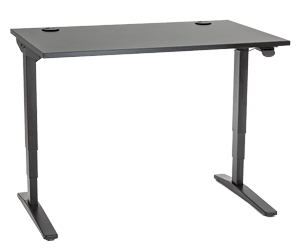

If you’re looking for a standing desk you can truly make your own, check out Uplift’s options. It has the most customizable desktop and frame choices of the desks we looked at.
The model we evaluated, with a V2 C-frame, can be lowered to about 25 inches and raised to just over 50.5 inches, which should be able to accommodate a wide range of statures. (The top-scoring standing desks on this list for ergonomic design can go slightly lower.)
The Uplift also offers a “commercial frame” option for about $80 more. We didn’t test that frame, but the company says it should comfortably accommodate users with heights from 5 feet up to 6 feet, 3 inches. That puts an Uplift V2-Commercial desk on a par with the Ikea Bekant.
For our evaluation, we chose the Advanced Paddle Keypad because it has a unique interaction mechanism. You can change the height of the desk by pressing up or down on the paddle controller—and the Uplift desk allows you to save and access two height presets by double-tapping the paddle keypad. We found the paddle keypad tricky to set up and not as intuitive to use as the other controllers, but Uplift offers other types of keypads, such as one with numbered buttons, that may be more straightforward.
Uplift’s Advanced Paddle Keypad also offers standing and sitting reminders—the keypad will vibrate and show a graphical alert according to the intervals you set (10, 20, 30, 60, or 120 minutes). Setting up the reminders is clunky, though, and there’s no audible reminder.
It took our test technicians 75 minutes to assemble the Uplift standing desk. The manual is nicely sized, with graphics and written instructions that are laid out logically. But the instructions are still confusing to follow because they cover multiple frames.
Uplift offers a vast array of potential configurations—over 100 desktops (from common laminate to solid wood and rare wood options, in widths from 42 inches to 80 inches), over 200 accessories, and more than 10 frames. This makes customizing your desk to your home office style easy, but depending on what you choose, the final bill can easily top $1,000.
Price as tested: $699
User height range: 5’3” to 6’7”
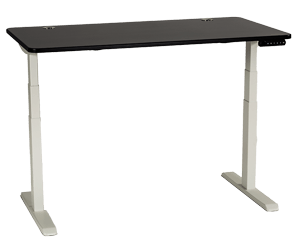

This desk can be controlled by the Autonomous smartphone app; in fact, you have to install the app and connect it to the desk via WiFi to complete the initial setup. Keester, the CR ergonomist who led the standing desks evaluation, says the app doesn’t provide a lot of additional value, but some users may enjoy controlling their desk from their phone.
The Autonomous desk’s keypad lets you save three height presets for lowering or raising the desk, and the app offers one extra seated and one additional standing height preset. Like the Vari desk above, the Autonomous should accommodate users who are 5 feet, 3 inches tall and up.
It took our test technicians a not-so-enjoyable 65 minutes to complete the desk assembly, which has a manual with extremely small graphics and text that were inaccurate or confusing in places. The frame was difficult to align with the predrilled holes without the assistance of a flashlight. Recommended assembly tools include a tape measure, drill, and an included Allen key.
The app also has a schedule function to raise or lower the desk at timed intervals, but that feature turned out to be a dud during our evaluation. The desk didn’t automatically go up or down as planned.
We also experienced another problem. When we set up the desk, the anti-collision feature was turned off, even though the setting appeared to be toggled on in the app. When we tried saving the app setting (without making changes to it), the feature turned on.
The SmartDesk Connect is available in a 53x29-inch desktop (width by depth) or an XL version measuring 70.5 inches by 30 inches. Desktop colors are limited to white, black, and gray, with the same color options for the frame. You can also choose between round leg frames and the more traditional square frames.
Buy at: Autonomous
Price as tested: $750
User height range: 5’5” to 6’8”+
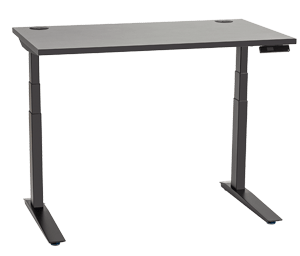

The three-stage frame that we tested on this model, designed by Fully and now sold under the Herman Miller brand, has a wide height range. But at its lowest setting, the desk can comfortably accommodate only users who are 5 feet, 4.5 inches or taller.
However, like the Uplift desk, the Jarvis has other frame options we didn’t test that could be a better fit. The three-stage “low” frame, which has a reported height range of about 23 inches to 43 inches, should comfortably accommodate people who measure anywhere from 5 feet, 1 inch tall up to 5 feet, 9 inches. The slightly less expensive 2-stage frame caters to taller users, between 5 feet, 9.5 inches and 6 feet, 6.5 inches. Because of the limited height ranges of these frames, it could be challenging to share a desk with others in your household.
When it comes to adjusting the desk height, the Jarvis desk stands out because it has a touchscreen display with no physical buttons. While that adds a minimalist look to the desk, we found the keypad doesn’t always register touch input, and it takes at least two taps to adjust the desk (the first to wake the display and the second to select the preset). A more basic up/down handset is another option for the desk, but it’s not programmable.
It took our test technicians 45 minutes to assemble the Jarvis desk. We found the instructions difficult to use because they incorporate very small drawings and text. Also, the instructions referred to hardware as letters but the hardware bags weren’t labeled that way, requiring a bit of puzzle-solving.
The model we tested has a 48x27-inch (width by depth) desktop, and there are two other sizes available: 60x27 inches and 72x30 inches. There are seven laminate finishes to choose from, and black, gray, and white leg color options. Herman Miller sells another standing desk designed by Fully, the Jarvis Bamboo Standing Desk, which—you guessed it—has a bamboo desktop.
Buy at: Herman Miller
Price as tested: $469
User height range: 5’5” to 6’8”+
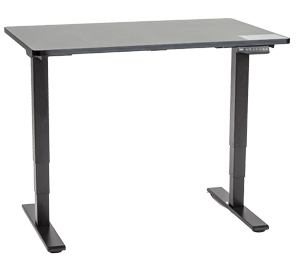

This desk can’t be lowered as much as the other models we evaluated—only to 25.5 inches from the floor—and shorter folks may want to look elsewhere. The desk’s standout feature is an audible interval timer, but we wouldn’t buy this desk just for that function.
We found the FlexiSpot’s advanced keypad to be easy to read because it’s mounted at an angle, similar to Vari’s controller. With the advanced keypad, you can save up to three heights, set a “long time sitting reminder,” and adjust the desk’s anti-collision sensitivity. Unlike other models in this list with programmable keypads, however, it’s missing functionality such as setting the desk’s upper or lower height limits, changing the display units, recalibrating the height, and locking the control panel.
This desk is the only one we tested with an audible interval timer or reminder that can be set from 1 to 99 minutes. When the countdown reaches 0, the keypad emits a beeping sound for 10 seconds, and if you don’t change the height of the desk after that reminder, there will be a second reminder after 5 more minutes. While this can come in handy, a few participants found it annoying. A better solution might be to just set a timer with your phone or refer to your smartwatch’s prompts to get moving.
It took our test technicians 45 minutes to complete the assembly of this desk. The hardware was separated and labeled by steps, which was helpful. But on the unhelpful side, there are no predrilled holes for the middle of the center support or the control box. Like the Autonomous desk, FlexiSpot’s instructions call for a drill.
This desk can be purchased with one of several desktop materials and color options or without a desktop if you have your own. The model we tested has a chipboard desktop measuring 48x30 inches (width by depth), but the desk is available in sizes up to 80 inches. (FlexiSpot offers another frame option for the desk, but it has a more limited height range, starting 3 inches higher.)
How We Evaluated Standing Desks
Our evaluation was led by Dana Keester, an ergonomics expert in CR’s Consumer Experience & Usability Research group. It had three distinct phases: 1) a consumer experience study in which we gathered feedback from 24 current standing desk owners to understand their experience and values; 2) an assembly phase in which two CR testing technicians unboxed and built each desk according to its instructions; 3) a use session in which 15 CR employees used and provided feedback on the desks.
For an apples-to-apples comparison, we ordered the desktops to be as similar in size and materials as possible. Most were 48 by 30 inches (width by depth) and made of laminate.
We scored each desk on a scale of 1 to 5, with 5 being the best, for ergonomic design, ease of use, and assembly.
For ergonomic design, we measured the minimum and maximum heights of each desk, from the floor to the top of the desktop surface. Keester then used widely used human factors engineering guidelines to calculate the recommendations for what user height ranges the desks can comfortably fit, based on seated and standing elbow heights.
Note that people of the same height can have different torso and leg lengths, so these user height recommendations are estimates. When seated, you should be able to use your keyboard with your elbows bent at around 90 to 120 degrees, while your feet are flat on the floor. (You can find more detailed information in CR’s reviews of the best office chairs.)
During the assembly phase, CR’s two testing technicians documented the tools needed for the assembly and whether they were provided, any problems found with the instructions, any steps they had to take that deviated from the instructions, assembly time, and their perception of how easy or hard it was to complete the process.
Next, 15 CR employees each worked at two different desks, spending a minimum of 2 hours at each desk. They adjusted each desk from seated to standing height and back four times, standing for at least 6 minutes out of every 30. The participants followed instructions on how to find their ergonomically best seated and standing desk heights and were asked to save the heights using the desks’ memory feature if one was available. They also set up sit-stand reminders or interval timers for the desks that had that option.
Each desk was used by five participants who provided feedback both after setting up the desk, and again at the conclusion of each study session.
Standing Desk FAQ
Here are some frequently asked questions and general guidelines for choosing a standing desk and using it properly.
How Hard Is It to Assemble a Standing Desk?
Standing desks are heavy; the frame alone can weigh over 50 pounds and the desktop can weigh just as much. Most desk parts are delivered in two giant boxes that may take two people to lift, and you may need two people to turn the desk upright once it has been assembled.
That said, you don’t need to be a mechanic or have special skills to assemble a standing desk. If you’re good using an Allen wrench, screwdriver, and (for some of the desks) a drill, you can assemble one of these desks on your own.
Or you could hire a service to assemble your desk for you. On Ikea’s website, you have the option to get a quote from TaskRabbit, which can vary by location. We got quotes from $30 to $43.
What Should You Look For in a Standing Desk?
The most important thing is to look for a model that can accommodate you both when you’re seated and standing. You can use the height of your elbow as a guide. While seated in your office chair with your feet flat on the floor, relax your shoulders and let your arms hang by your sides, then bend your elbows to about 90 degrees, keeping your wrists straight and your fingers relaxed. This is the height that your keyboard and mouse should be on your desk, so make sure that any standing desk you select goes at least this low, unless you plan to add a keyboard tray. Repeat this process while standing to ensure that the desk you select goes high enough.
Many standing desks can’t accommodate people who are the average height for women (5 feet, 4 inches) or shorter, so if that describes you, pay special attention to how low the standing desk can go.
Current standing desk owners emphasize that you should also make sure the desktop is large enough. “The biggest advice I would give a friend who is considering a standing desk, is to really think about how the devices are going to be installed on your desk,” said one owner, “and make sure you have a plan for how much space you actually need.”
A number of current owners emphasized the importance of memory presets, and several of our standing desk evaluation participants echoed this, as well.
What Standing Desk Accessories Should You Get?
You might not need all of these items, but they can make using your desk more ergonomic.
- Office chair: A great desk is only part of the picture when it comes to ergonomics. You also need an appropriately sized and adjusted office chair.
- Standing mat or anti-fatigue mat: This can provide a cushioned surface to help reduce strain on your feet, legs, and lower back when you’re standing. Some standing mats have contoured surfaces to encourage movement or massage your feet.
- Cable management: The movement of sit-stand desks makes cable management particularly important. When your cords are organized and out of the way, you can achieve a safer, more efficient, and aesthetically pleasing workspace. Some standing desks come with either built-in cable management devices or accessories like cable ties that can help. Desks may also have grommets to corral wires; some grommets also serve as an easy-to-reach power outlet.
- Monitor arm: The top of your monitor should be at or just below your eye level, but this may require a different monitor position when sitting than standing. An adjustable monitor base, stand, or arm can ensure the monitor is always in the right position.
- Keyboard tray: If you’re relatively short, your sit-stand desk still might not go low enough to sit with both feet flat on the floor and your shoulders relaxed, with wrists and hands at or just below the height of your elbows when typing. One solution is to add a keyboard tray that’s compatible with a sit-stand desk.

















